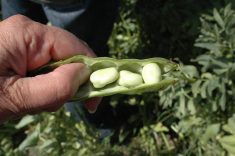CNSC / ICE Futures Canada canola held rangebound for the most part during the week ended Nov. 15, but dropped sharply on Friday to settle with losses overall.
The January contract tested the psychological $500-per-tonne level a couple of times during the week, but never managed to settle above that chart point. A firmer tone in the outside vegetable oil markets, including CBOT (Chicago Board of Trade) soyoil and Malaysian palm oil, was also supportive. However, Canada’s record-large crop continues to overhang the market, with any attempts at moving higher being met with increased selling and a downturn in demand.
Read Also

New crop insurer policy enables easier startup for faba beans
Agriculture Financial Services Corporation updated its normals for faba beans, which may open the door for more Canadian producers to feel comfortable growing the pulse crop in the future.
The next resistance comes in at around $505 if canola manages to bounce above $500, but it will take a weather scare in South America or some other similar outside influence to spark a rally as most factors are pointing down for the time being.
First and foremost, Canada grew a record-large canola crop this year that was likely over 16 million tonnes. Farmers are storing what they can in hopes of getting better prices down the road, but end-users are well aware of the big supplies and will need that outside catalyst in order get more aggressive in their buying.
Second, South America is in the middle of planting its latest soybean crop, and conditions so far look close to ideal for a possibly record-large crop.
The U.S. soybean harvest is nearing completion. Farmers there will also store what they can, but supplies are still relatively large.
Ongoing uncertainty in the global economy is yet another bearish influence overhanging the commodity markets in general, although any resulting weakness in the Canadian dollar would serve to limit the impact on canola prices.
Wheat moves lower
In the U.S., soybeans, corn and wheat all posted losses for the week. For beans and corn, the declines were tied to profit-taking after initially moving higher. News the U.S. was considering reducing its ethanol mandate, which would lead to a reduction in demand for corn as a feedstock as well, put further pressure on corn.
The three U.S. wheat contracts, meanwhile, have been trending lower for the better part of the past two months and remained stuck in that trend.
However, there were signs that the wheat futures were starting to find a bottom, with U.S. prices said to be looking more favourable internationally once again. Short-covering was also starting to come forward in wheat.
Soyoil and oats were the two bright spots in the U.S. grain and oilseed markets during the week. Oats supplies are relatively sufficient to meet the demand, but logistical issues getting the crop into delivery positions were keeping it propped up so far.
The relative strength in soyoil was linked in part to the strength in the Malaysian palm oil market. Good export demand for the tropical oil kept prices near their highs for the year, while the possibility of supply disruptions due to the damage caused by Typhoon Haiyan in the Philippines was also underpinning that market.















